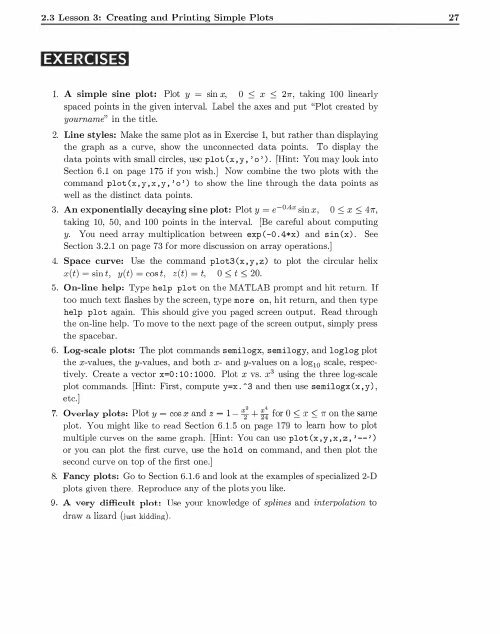You also want an ePaper? Increase the reach of your titles
YUMPU automatically turns print PDFs into web optimized ePapers that Google loves.
2.3 Lesson 3: Creating and Printing Simple Plots<br />
'27<br />
EXERCISES<br />
1. A simple sine plot: Plot y = sin x, 0 :::; x :::; 21r, taking 100 linearly<br />
spaced points in the given interval. Label the axes and put "Plot created <strong>by</strong><br />
yourname" in the title.<br />
2. Line styles: Make the same plot as in Exercise 1, but rather than displaying<br />
the graph as a curvf!, show the unconnected data points. To display the<br />
Jata points with small circles, uc plot (x, y, 'o'). [Hint: You may look into<br />
Section 6.1 on page 175 if yon wish.] Now combine the two plots with the<br />
command plot (x, y, x, y, 'o') to show the line through the data points as<br />
well as the distinct data points.<br />
3. An exponentially decaying sine plot: Plot y = e-0.4x sin x, 0 :::; x :::; 471",<br />
taking 10, 50, and 100 points in the interval. [Be careful about computing<br />
y. You need array multiplication between exp(-0.4*x) and sin (x) . See<br />
Section 3.2.1 on page 73 for more discussion on array operations.]<br />
4. Space curve: Use the command plot3 (x, y, z) to plot the circular helix<br />
x(t) = sint, y(t) = cos t, z(t) = t, 0 ::=;; t ::=;; 20.<br />
5. On-line help: Type help plot on the <strong>MATLAB</strong> prompt and hit return. If<br />
too much text flashes <strong>by</strong> the screen, type more on, hit return, and then type<br />
help plot again. This should give you paged screen output. Read through<br />
the on-line help. To move to the next page of the screen output, simply press<br />
the spacebar.<br />
6. Log-scale plots: The plot commands semilogx, semilogy, and loglog plot<br />
the x-values, the y-values, and both x- and y-values on a log10 scale, respectively.<br />
Create a vector x=O : 10: 1000. Plot x vs. x3 using the three log-scale<br />
plot commands. [Hint: First, compute y=x. 3 and then use semilogx (x, y) ,<br />
etc.]<br />
7. Overlay plots: Plot y = cos x and z = 1- x22 + : for 0 ::=;; x ::=;; 1r on the same<br />
plot. You might like to read Section 6.1.5 on pagf! 179 to learn how to plot<br />
multivle curves on the same graph. [Hint: You can use plot (x, y, x, z, ' -- ' )<br />
or you can plot the first curve, use the hold on command, and then plot the<br />
second curve on top of the first one.]<br />
8. Fancy plots: Go to Section 6.1.6 and look at the examples of specialized 2-D<br />
plots given there. Reproducf! any of the plots you like.<br />
9. A very difficult plob Use yonr knowledge of splines and interpolation to<br />
dmw a lizard (iust kiddin.o;) .



